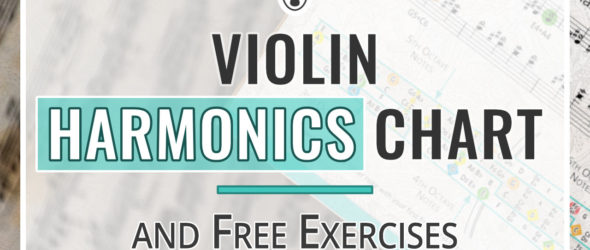Get a free violin harmonics chart, exercises, and learn how to play harmonics on your violin!
Harmonics on the violin, as well as on the other instruments of the violin family, is a very confusing subject. Yet, this technique is very useful, especially when playing more contemporary repertoire but they appear also in the orchestra repertoire or solo pieces.
In this blog post, I’d like to explain to you in detail the notation of harmonics and share with you a chart that will help you decipher them whenever you happen to see some harmonic notes in the sheet music. Moreover, I prepared for you a set of exercises, so you can master reading and playing harmonics on your violin!
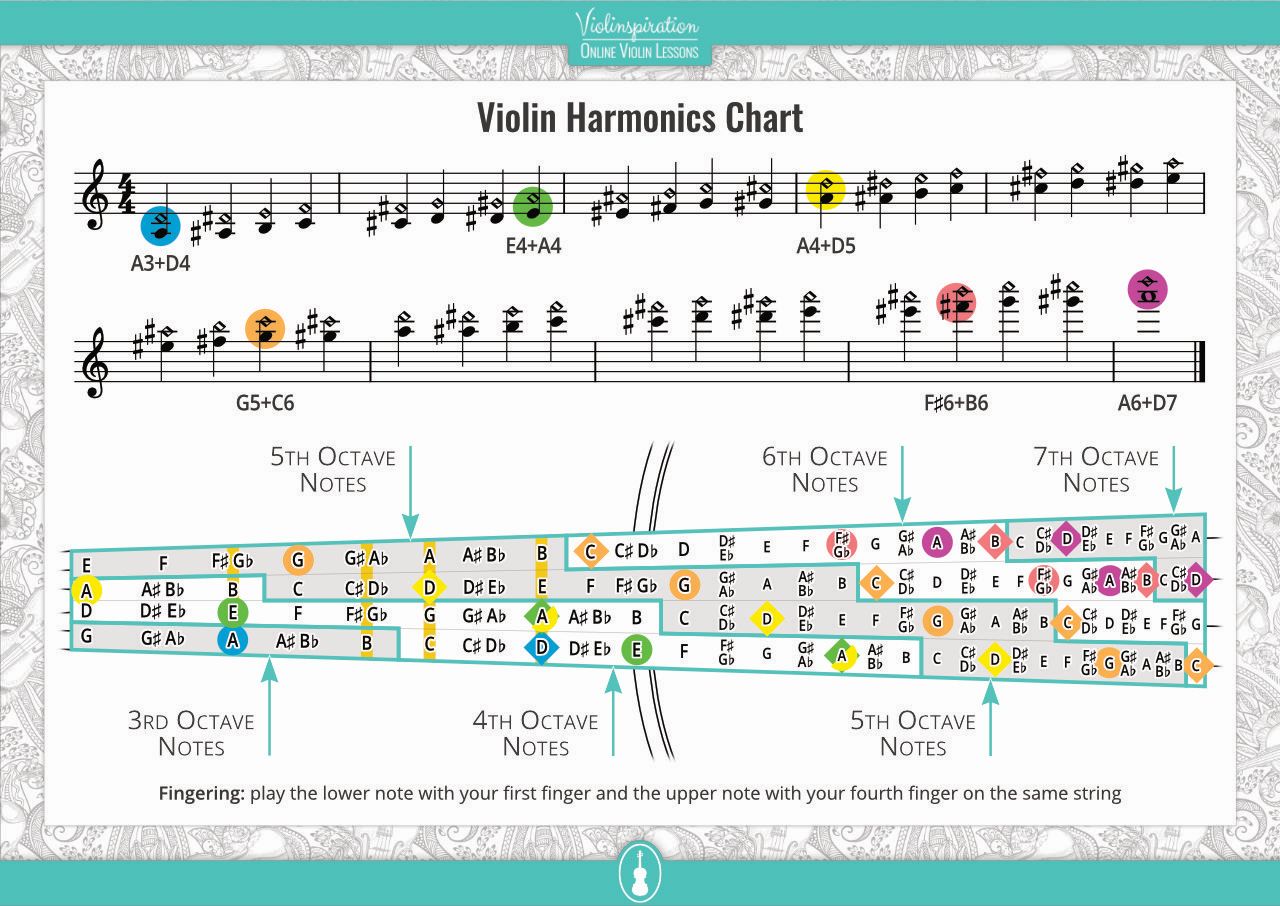
FREE Artificial Harmonics Chart
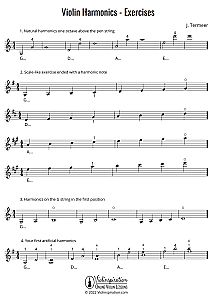
Violin Harmonics Exercises
Free Sheet Music
If You’re New to the Violin Harmonics…
If you’re new to violin harmonics and you’d like to learn basic information about them and also listen to me playing some examples for you, make sure to first read my article “Violin Harmonics Simplified – So You Can Play Them Easily.”
Benefits of Learning Harmonics on the Violin
You might be wondering why would you learn this difficult technique. Here are the three benefits you can get out of learning harmonics:
1. Tuning & Intonation
Natural harmonics are the clearest notes you can play, other than open strings. They can help you with tuning your instrument (if you decide to tune it by ear) and you can check your intonation by stopping a note and comparing it with the same note one octave above. Moreover, playing harmonics requires placing your fingers very precisely, so while learning them you’re also improving your intonation of regularly stopped notes.
2. Sound effect
Harmonics add a new way your violin can sound. The sound effect might be very useful when playing with others, creating your own music, or just experimenting. Especially in modern music, you can play a harmonic note with delay or slide to create a “seagull” effect.
3. Repertoire
You get to know a very useful violin technique. Harmonics started being used a lot since romanticism and also they are present in more modern styles. Orchestra players can’t avoid them, as it is frequently used in their repertoire.
Why Harmonics are so Confusing?

What is confusing in violin harmonics is the sheet music notation, as well as the placement of the finger(s).
There are multiple ways to write the same harmonic note in the sheet music, with a 0, or 0/4, or a diamond head, and sometimes even just a “harm.” Also, there are multiple ways to play the same harmonic note, depending on the string and position that you’re choosing.
That’s not all, when you listen carefully (or check it with a tuner), you’ll notice that a note played as a harmonic is different than the note you get when you press a string down to the fingerboard. So for example, your third finger on the G string does not produce a C note but rather a G – the same as if you used your low second finger on the E string! This effect results from physics but don’t worry, I’m not going to analyze it here. Instead, let’s focus on the practical aspects.
How to Play Harmonics on the Violin
Here’s a small recap on how to play harmonics on the violin based on their type.
How to play natural harmonics on the violin?
In order to play a natural harmonic note on your violin, gently put your finger on the string (without pressing) to create a flute-like ghostly sound. You can do that e.g. on a note that is an octave higher than an open string, but you can also play it on the third, fourth, and fifth.
How to play artificial harmonics on the violin?
To play an artificial harmonic, first stop a note with your first finger – press the string down to the fingerboard. Then, gently press an upper note with your fourth finger just as in case of a natural harmonic.
In this case, your first finger shortens the open string and the fourth finger plays a harmonic note that is a fourth above. The harmonic can also be played on the third and fifth but it’s not that common.
How Do You Read Violin Harmonics?
Let me now help you decipher the notation and understand how to read harmonics in the violin sheet music.
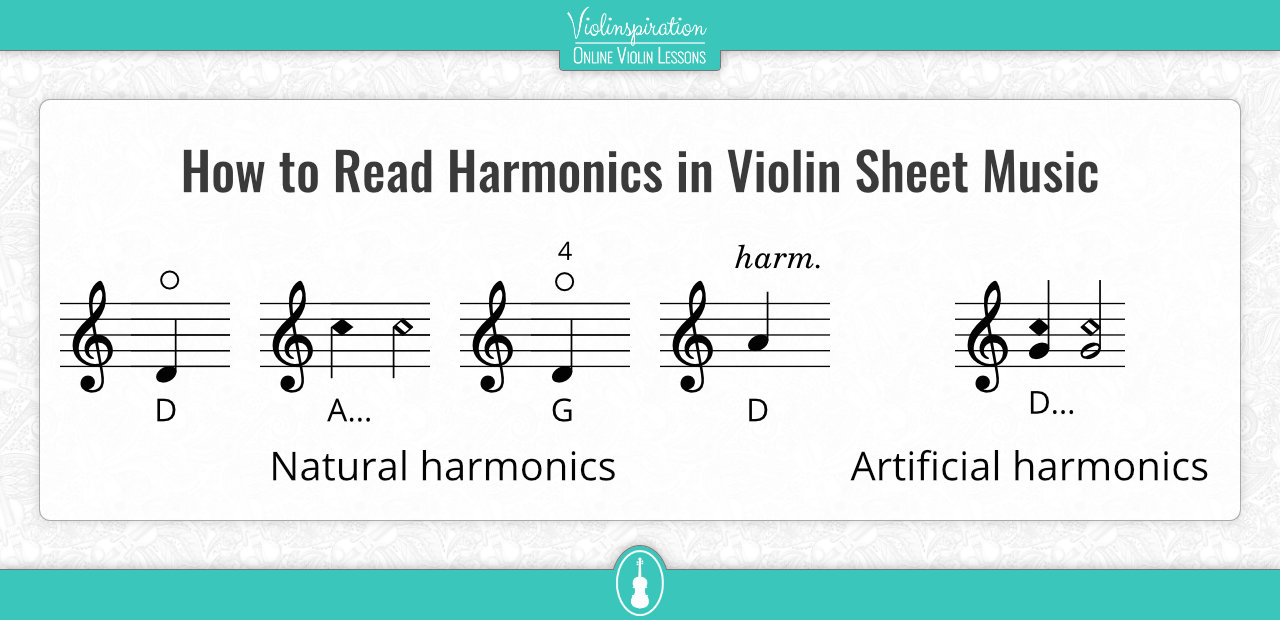
How to Read Natural Harmonics in Violin Sheet Music
There are multiple ways a natural harmonic might be notated:
1. Circle above the notehead
The most common notation is a ‘0’ (circle) above the notehead. Since it’s not zero that would suggest an open string, it should be a natural harmonic.
2. A diamond notehead
A diamond notehead indicates that it’s a harmonic note. Don’t confuse it with artificial harmonics, which are written similarly to double stops.
3. Circle (or zero) and finger number
Sometimes you might see two numbers above the note, one is 0 (circle or zero) and the other is usually 4, and less common are 2 and 3. ‘0’ represents that it is a natural harmonic and the other number represents the finger you should use.
4. Directly indicated with “harm.” above notes
Finally, you might just see “harm.” above a passage or several notes. It’s not that common and usually can be found in older or non-professional sheet music. This falls under the same logic as when you see “staccato” written.
How to Read Artificial Harmonics in Violin Sheet Music
An oval notehead below and a diamond notehead above mean that it’s an artificial harmonic. The regular notehead represents where to put your first finger. The diamond notehead shows where your fourth (or sometimes third) finger should touch the string.
When you see artificial harmonics in the sheet music, most likely it will be one of the following intervals:
- Fourth – if the diamond note head is a fourth above it means you should play it with your fourth finger. It will sound two octaves above the stopped note. This is the most common use of that technique.
- Fifth – if the diamond note head is a fifth above the stopped note, play it with your fourth finger. It will produce a tone that is one octave above the note you’re touching with your fourth finger.
- Third – if the diamond head is a third above the stopped note, play it with your third finger and it will produce a note two octaves and a fifth above the harmonic note.
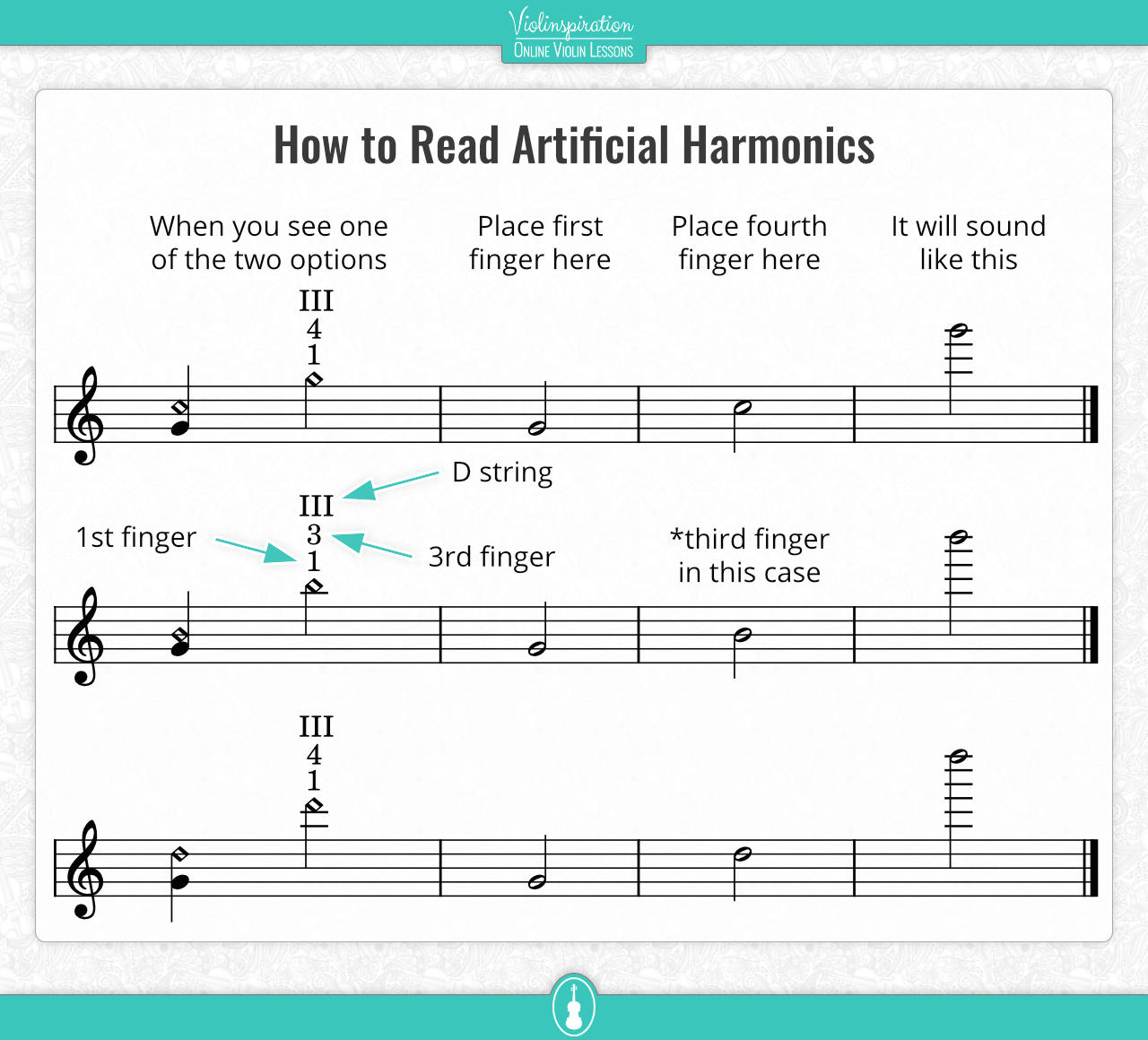
Double Violin Harmonics
Playing two natural harmonics at the same time is possible! As long as they are on adjacent strings, you can lightly touch the two strings with one finger. In very advanced pieces, you can also find double artificial harmonics. As an example, have a look at an excerpt from Paganini’s 9th Caprice.
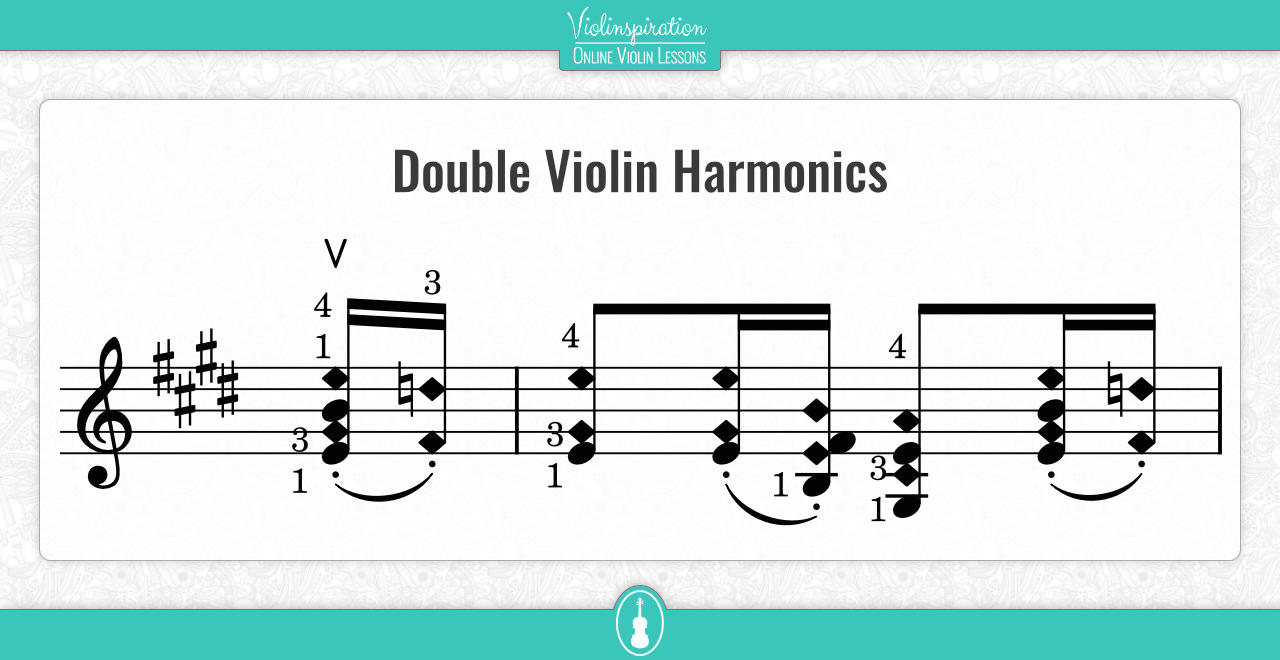
Violin Harmonics Chart
Now, when you know how to read harmonics in the sheet music, let’s see where you should put your fingers on the fingerboard to play them. I hope that this chart will help you with it.
Artificial Harmonics Chart


FREE Artificial Harmonics Chart
The chart contains sheet music notation of artificial harmonics, all notes on the violin fingerboard, and six examples, each marked with a color on the staff and on the fingerboard. Circle on the fingerboard means that your first finger goes there and your fourth finger goes to a marker in the same color but with diamond shape.
On the fingerboard, you can see indication to which octave given notes belong. It refers to the international pitch notation, where sounds and their exact pitches are classified into octaves. On the violin with the standard tuning of GDAE (A=440 Hz), we can use five last notes from the third octave, whole fourth, fifth, and six octaves, as well as almost whole seventh octave.
For example, there is G5 and C6 marked with the orange color. You can play this harmonic on each string. That’s because each violin string contains notes from the fifth octave and the C6 note. Can you localize the notes on each string?
As a starter, try playing this harmonic on the E string. To do this, you’ll have to shift to the second position, stop the G note with your first finger, and lightly touch the string where the C note is. Next, try to repeat it on the A string. If you’re ready to explore the top part of the fingerboard, go ahead and find these notes on the D and the G string.
Make sure to download the chart so when next time you find any harmonics in your sheet music, you’ll be able to localize the notes on this chart and based on that choose on which string and in which position you’ll play them.
How to choose the right position on the fingerboard to play harmonics?
In general, this should be something you can decide based on what is more convenient for you. Check out the position you are in, as well as what you have in the sheet music after and before it, and you’ll find the easiest way to play it.
Here you can use similar principles as for choosing in which position to play: avoid unnecessary shifting, check what will be easier to play, and what will sound better.
How to Study Harmonics on the Violin
Learning harmonics is quite some challenge, so I also prepared a set of exercises that will help you develop this technique. You can download it here:

Violin Harmonics Exercises
Free Sheet Music
You can pick one exercise at a time, or even only a part of it, and practice it until you can comfortable play it.
I recommend you to first try playing natural harmonics, then learn the artificial ones. You can do some tests on the first position before trying to play anything higher on the fingerboard. Keep in mind that the intervals will become smaller as you go up, similar to what happens when you play in higher positions.
When you play harmonics, your bow plays a crucial role. Use long bow strokes and always make sure to play with a straight bow. Also, play a bit closer to the bridge. Your goal should be to produce the clearest sound possible.
Harmonics in the Violin Repertoire
Now, let’s listen to a few violin pieces that make use of harmonics.
Edmund Severn – Polish Dance
Severn was an American composer and violinist. He mainly composed orchestral work as well as works for the violin. His “Polish Dance” is one of his most famous pieces.
If you’re eager to study this piece, check out the whole course on it – Julia’s Violin Academy members only.
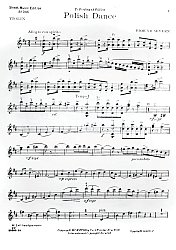
Polish Dance by Edmund Severn
Free Sheet Music
Vittorio Monti – Czardas
A very famous piece, usually played as an encore, Czardas has sporadic use of natural harmonics but most notably, the “Meno, Quasi Lento” part is played in its entirety with artificial ones, starting at 2.56.
Would you like to learn this piece? Click here and see what are my best tips on playing it!
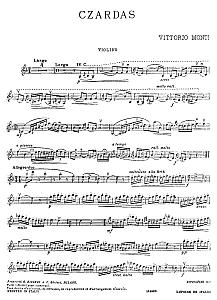
Czardas by Vittorio Monti
Free Sheet Music
Maurice Ravel – Tzigane
A famous composer, and one of the leading figures of impressionism. He was influenced, among other things, by jazz and atonality. His Tzigane makes use of all types of harmonics.
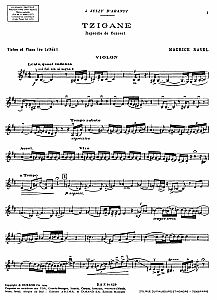
Tzigane by M. Ravel
Free Violin Sheet Music
Final Note
Hopefully, you now have a good understanding of harmonics on the violin and you’re ready to try them out! Keep the harmonics chart around as it can be useful in the future. Also, good luck with practicing the exercises!

Violin Harmonics Exercises
Free Sheet Music
